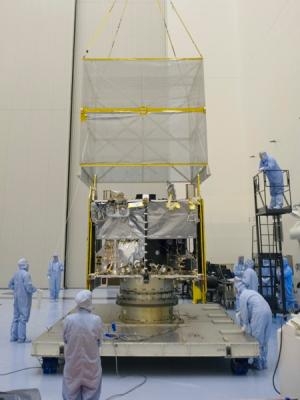MAVEN Spacecraft Arrived Last Friday At Kennedy Space Center
NASA's next spacecraft going to Mars arrived Friday, Aug. 2, at the agency's Kennedy Space Center in Florida, and is now perched in a cleanroom to begin final preparations for its November launch. The Mars Atmosphere and Volatile Evolution (MAVEN) spacecraft is undergoing detailed testing and fueling prior to being moved to its launch pad. The mission has a 20-day launch period that opens Nov. 18.

The spacecraft will conduct the first mission dedicated to surveying the upper atmosphere of Mars. Scientists expect to obtain unprecedented data that will help them understand how the loss of atmospheric gas to space may have played a part in changing the planet's climate. "We're excited and proud to ship the spacecraft right on schedule," said David Mitchell, MAVEN project manager at NASA's Goddard Space Flight Center. "But more critical milestones lie ahead before we accomplish our mission of collecting science data from Mars. I firmly believe the team is up to the task. Now we begin the final push to launch."
Over the weekend, the team confirmed the spacecraft arrived in good condition. They removed the spacecraft from the shipping container and secured it to a rotation fixture in the cleanroom. In the next week, the team will reassemble components previously removed for transport. Further checks prior to launch will include software tests, spin balance tests, and test deployments of the spacecraft's solar panels and booms.
The spacecraft was transported from Buckley Air Force Base in Aurora, CO, on Friday, aboard a U.S. Air Force C-17 cargo plane. Lockheed Martin Space Systems in Littleton, CO, designed and built the spacecraft and is responsible for testing, launch processing, and mission operations. "It's always a mix of excitement and stress when you ship a spacecraft down to the launch site," said Guy Beutelschies, MAVEN program manager at Lockheed Martin. "It's similar to moving your children to college after high school graduation. You're proud of the hard work to get to this point, but you know they still need some help before they're ready to be on their own."
Previous Mars missions detected energetic solar fields and particles that could drive atmospheric gases away from Mars. Unlike Earth, Mars does not have a planet-wide magnetic field that would deflect these solar winds. As a result, these winds may have stripped away much of Mars' atmosphere. MAVEN's data will help scientists reconstruct the planet's past climate. Scientists will use MAVEN data to project how Mars became the cold, dusty desert planet we see today. The planned one-year mission begins with the spacecraft entering the Red Planet's orbit in September 2014. "MAVEN is not going to detect life," said Bruce Jakosky, planetary scientist at the University of Colorado Boulder and MAVEN's principal investigator. "But it will help us understand the climate history, which is the history of its habitability."
MAVEN's principal investigator is based at the University of Colorado Laboratory for Atmospheric and Space Physics in Boulder. The university provides science instruments and leads science operations, education and public outreach.
(Pictured: NASA’s Mars Atmosphere and Volatiles Evolution (MAVEN) spacecraft is seen inside the Payload Hazardous Servicing Facility on Aug. 3. 2013 at the agency’s Kennedy Space Center in Florida.)
 ANN's Daily Aero-Term (05.17.24): Very High Frequency
ANN's Daily Aero-Term (05.17.24): Very High Frequency ANN's Daily Aero-Linx (05.17.24)
ANN's Daily Aero-Linx (05.17.24) ANN FAQ: Submit a News Story!
ANN FAQ: Submit a News Story! Classic Aero-TV: ANN Visits Wings Over The Rockies Exploration Of Flight
Classic Aero-TV: ANN Visits Wings Over The Rockies Exploration Of Flight Airborne Affordable Flyers 05.16.24: PRA Runway, Wag-Aero Sold, Young Eagles
Airborne Affordable Flyers 05.16.24: PRA Runway, Wag-Aero Sold, Young Eagles



